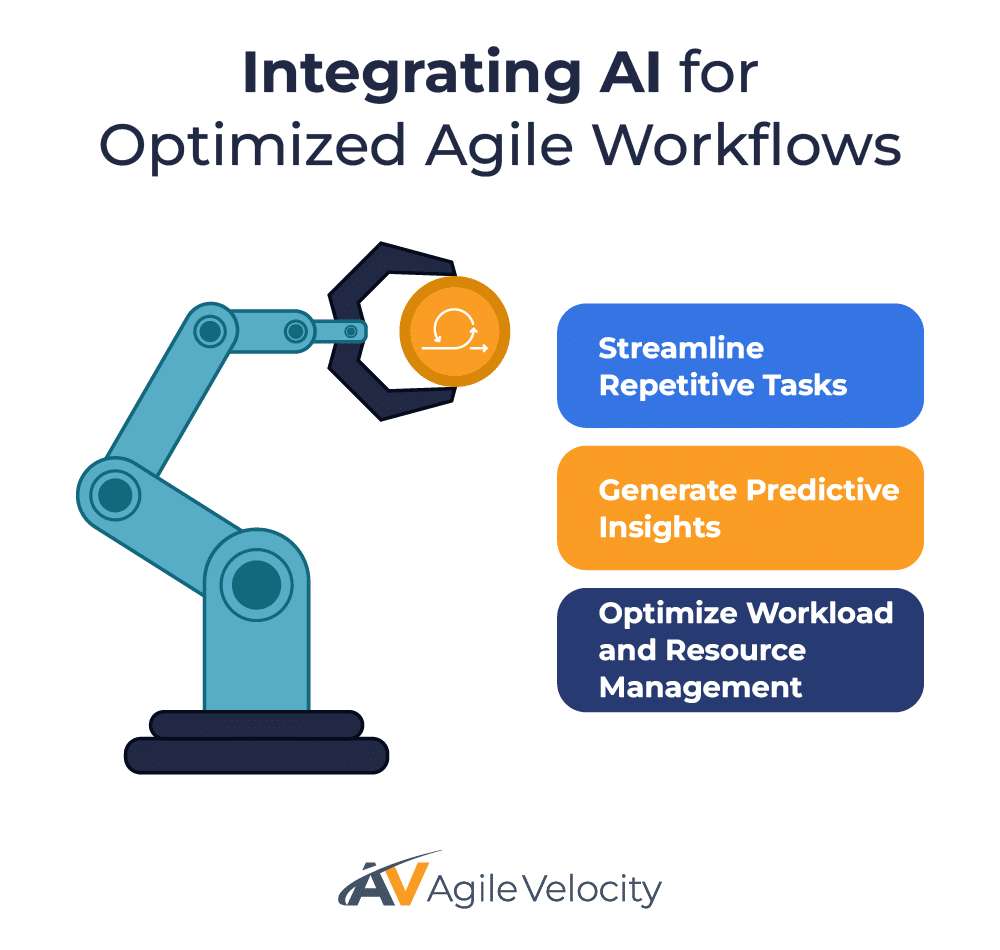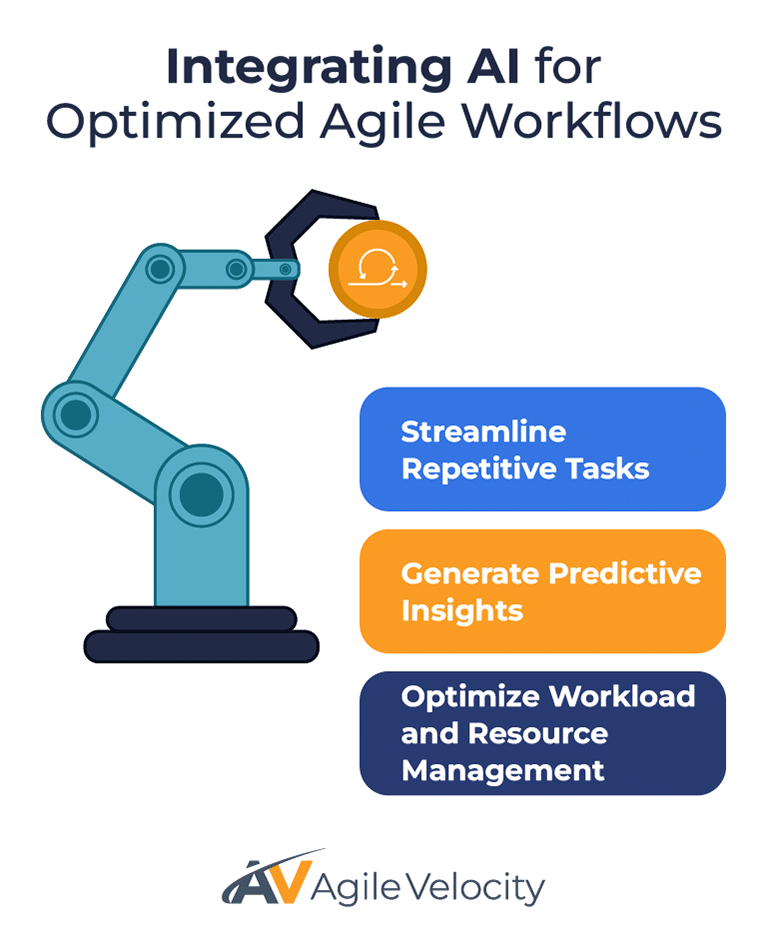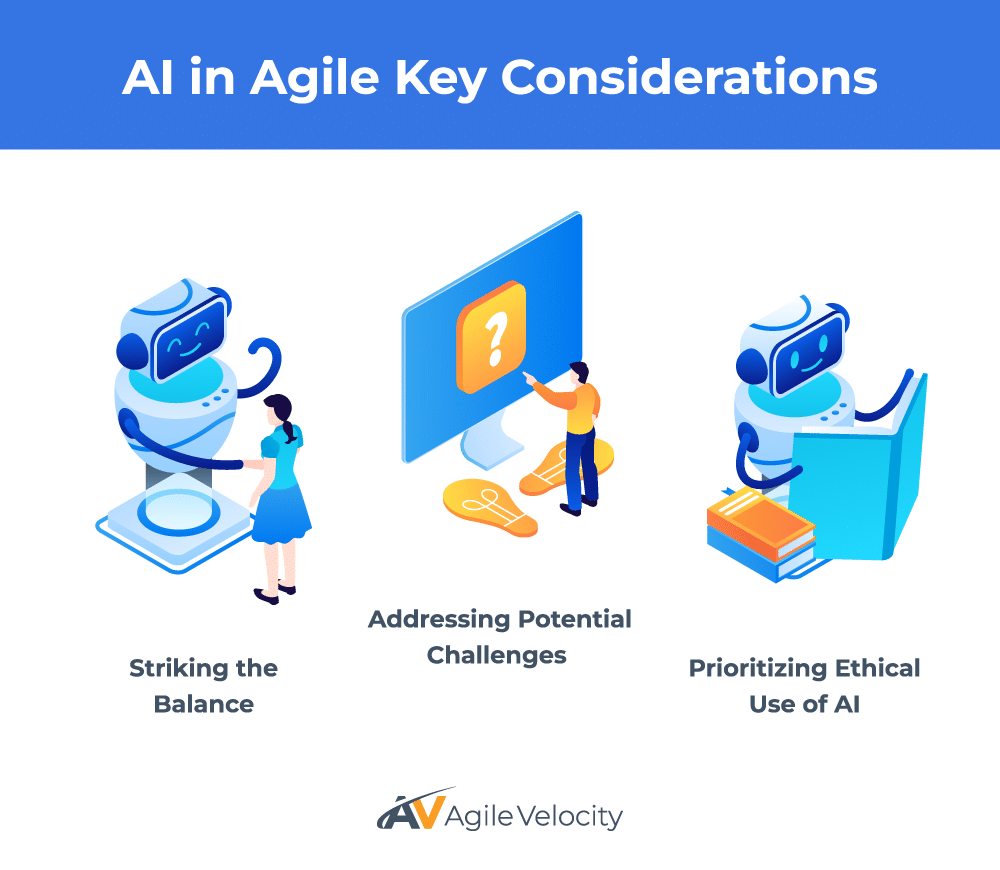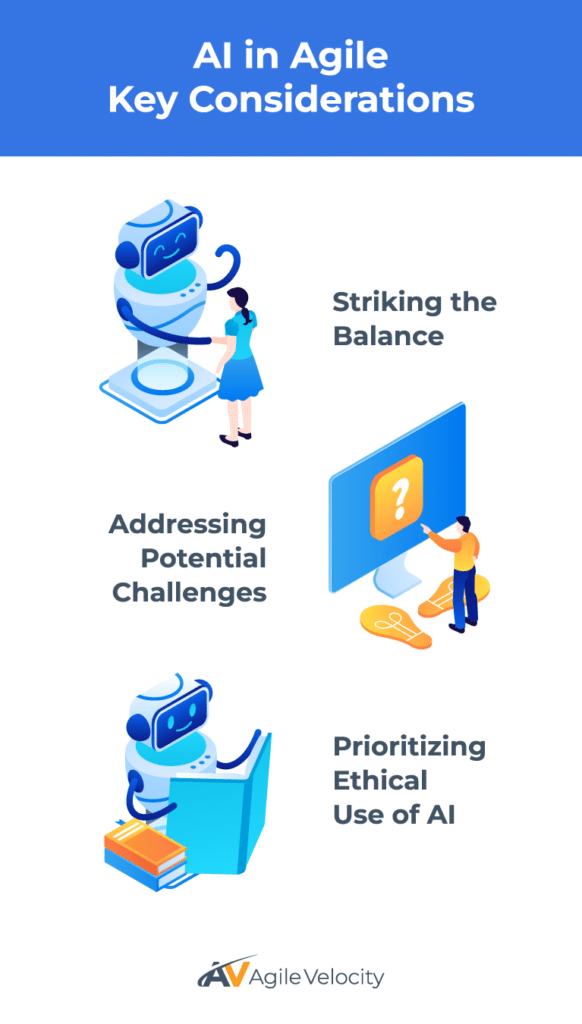In today’s fast-moving, technology-driven landscape, Agile development is pivotal to delivering value quickly, adapting to constant change, and exceeding customer expectations. However, as organizations scale in size and complexity, even the most skilled teams often face challenges in maintaining high efficiency, effective collaboration, and seamless workflows. This is where AI solutions can make a real difference: by working within Agile environments, AI can transform development strategies with automation, predictive insights, and enhanced team alignment.
AI doesn’t replace the human element essential to Agile—it complements it. From automating repetitive tasks to uncovering actionable data for better decision-making, AI empowers teams to focus on creativity, innovation, and delivering maximum customer value. Agile coaches, managers, and leaders can also leverage AI to improve organizational agility, optimize resources, and inform decision-making.
In this article, we’ll explore how integrating AI with Agile development strategies can streamline workflows, improve outcomes, and help organizations transition from traditional practices to more adaptive, value-focused ways of working.
The Role of AI in Agile Development Strategies
AI plays a crucial role in revolutionizing Agile development strategies by enhancing efficiency and accelerating innovation. By integrating AI into Agile practices, teams can automate routine tasks, gain predictive insights, and improve collaboration, leading to more streamlined and adaptive workflows. This synergy not only optimizes resource use but also empowers teams to deliver greater value to customers continuously.


Streamlining Repetitive Tasks with AI
One of the most immediate benefits of AI in Agile development lies in handling routine tasks, allowing teams to focus on delivering customer value. AI can take on tasks that can be automated, and can provide fast and efficient artifacts that teams can use as a starting point for development. This frees up more time and capacity for innovation, higher quality standards and features that delight customers.
AI can also quickly analyze codebases to detect potential issues, suggest optimizations, and expedite feedback loops. This improves quality, reduces manual bottlenecks, and fosters a seamless development workflow.
Generating Predictive Insights for Smarter Decisions
Agile thrives on adaptability. Maintaining continuous visibility into progress is crucial for making informed decisions. AI excels at analyzing historical and real-time data to uncover patterns, predict challenges, and recommend best courses of action. These insights help roles like Product Owners and Scrum Masters make better judgments when adjusting Sprint scope or prioritizing the work effectively.
Take task prioritization for example: AI can analyze backlog trends and provide recommendations for which items should be prioritized for maximum impact. In larger setups like Agile Release Trains in Scaled Agile Framework® (SAFe®) environments, AI tools can highlight early risk indicators if a team is at risk of missing Planning Interval (PI) Objectives. This proactive decision-making helps teams maintain alignment and deliver on Sprint Goals with fewer surprises.
Optimizing Workload and Resource Management
In Agile, balanced workloads are essential for sustainable productivity. AI offers an edge by analyzing team performance, skill sets, and capacity, providing actionable insights for more equitable task allocation. Leaders can ensure that no one is overloaded, preventing burnout while keeping work quality high.
At the portfolio level, organizations practicing Lean Portfolio Management can rely on AI to identify redundancies, flag risks early, and propose shifts of resources to higher-value initiatives. By improving the quality and availability of data supporting strategic decisions and streamlining portfolio management, teams can reduce waste, increase autonomy, and ultimately deliver greater value.
Enhancing Collaboration, Communication, and Team Alignment with AI
Integrating AI within Agile development not only enhances efficiency but also significantly boosts collaboration and communication among teams. By utilizing AI-powered tools, development teams can achieve better alignment, facilitate clearer communication streams, and ultimately foster a more cohesive working environment. This section explores how AI can bridge gaps in team dynamics, streamline information sharing, and ensure everyone is on the same page.
Revolutionizing Communication in Agile Teams
Collaboration thrives on clear, timely communication—especially in hybrid and distributed environments. AI tools can automate everything from scheduling collaborative sessions to providing real-time transcripts or summaries, easing communication logistics,capturing decisions, and fostering inclusivity.
Although human interaction remains vital, AI augments day-to-day exchanges by boosting feedback speed and ensuring quick alignment. Less time spent on administrative tasks means more time spent problem-solving and innovating together.
Bolstering Strategic Alignment
In any Agile framework alignment with strategic goals is a must. AI can continuously analyze data from backlogs and user stories to ensure that effort aligns with high-impact initiatives. It can spotlight discrepancies between current work and overarching business priorities, helping Agile leaders adjust as necessary.
AI also makes it easier to plan and execute return-to-office events by factoring in schedules, resource availability, and project timelines. This helps teams strengthen relationships, while minimizing potential disruptions to Sprints or Iterations.
AI-powered analytics can enhance accountability by linking decisions directly to measurable outcomes, provided that the AI systems are implemented with transparency and robust oversight, thereby also improving overall adaptability.
Enabling Hybrid Work Models
Hybrid work offers flexibility but requires careful oversight to maintain productivity and team cohesion. AI helps leaders spot changes in engagement or communication consistency, prompting timely support or in-person collaboration when needed. By simplifying scheduling and resource allocation, AI ensures hybrid events remain purposeful and beneficial to ongoing project work.
With AI supporting communication, alignment, and hybrid team dynamics, organizations are well-positioned to maintain productivity regardless of how or where teams work.
Build High-Performing Teams
Transitioning from Traditional to Agile Methods with AI Assistance
Shifting from a traditional project management approach to Agile is transformative yet challenging. Obstacles like resistance to change and unclear objectives can slow progress. AI offers clarity and support in this transition by identifying bottlenecks, analyzing workflows, and highlighting specific areas for improvement—giving teams a solid roadmap for change.
Addressing Common Challenges in Agile Adoption
Moving to Agile demands both a cultural shift and new operational models. AI can highlight inefficiencies, such as protracted handoffs or sluggish feedback loops, so leaders can pinpoint and resolve the most pressing challenges first. Gradual, evidence-based progress alleviates uncertainty among stakeholders, who see real data confirming Agile’s benefits in practice.
AI-equipped metrics also allow leaders to track throughput, gather feedback, and monitor engagement, making incremental improvements highly visible. For those unsure of Agile’s effectiveness, data-driven results help build the confidence needed to persevere through change.
Assessing Readiness and Measuring Maturity
A successful Agile adoption starts by gauging each team’s readiness. AI assesses whether teams can handle changing requirements, manage user stories, and remove blockers. Metrics like velocity, lead time, and defect rates reveal how well teams are performing—and where targeted coaching can help.
As organizations expand to multiple Scrum Teams or Agile Release Trains, AI supports consistent benchmarks across the entire enterprise. Identifying gaps in capabilities ensures that training, mentorship, or additional resources go exactly where they’re needed.
Building a Data-Driven Roadmap for Agile Transformation
Once an organization’s readiness is established, the next step is building an Agile Transformation roadmap. AI analyzes historical data, performance trends, and resource availability to recommend which practices to adopt first for maximum effect. This data-driven guidance allows leaders to balance strategic goals with real-world constraints.
While AI simplifies analysis and prioritization, human leadership is essential for driving cultural shifts, offering vision, and building trust. AI delivers structure and insights; people provide guidance, creativity, and empathy. This synergy ensures the transition remains both fact-based and human-centric, leading to lasting, positive change.
Practical Applications of AI in Agile Coaching, Roles, and Events

Integrating AI into Agile coaching and roles provides tangible benefits by automating tasks, improving data transparency, and enhancing strategic decision-making. AI can optimize Agile events like Sprint Planning or Retrospectives by providing real-time insights and improving inter-team communication. This section will explore how AI empowers Agile coaches and teams, driving more effective and cohesive event outcomes.
Driving Agile Coaching with AI-Powered Insights
Agile Coaching focuses on empowering teams to improve performance and collaboration. AI-enhanced analytics let coaches spot trends, detect recurring bottlenecks, and tailor interventions to specific team hurdles. Rather than applying generic fixes, coaches can use data to customize guidance—accelerating meaningful improvements.
AI can also run periodic team “health checks,” analyzing velocity, morale, and backlog quality. Coaches can deliver evidence-based advice that addresses a team’s unique challenges, ensuring each session results in genuine progress and fosters continuous improvement.
Enhancing Agile Roles with AI Support
For roles like Product Managers and Scrum Masters—AI can significantly amplify impact. Data on Sprint Goals, recurring roadblocks, and workload distribution gives leaders a clearer picture of what’s working and what isn’t.
Armed with these insights, the people in these critical roles can quickly offer targeted recommendations or scope adjustments. AI turns guesswork into informed decision-making, speeding up improvements and ensuring every recommendation is rooted in concrete data.
AI-Optimized Agile Events
Agile depends on effective events to keep alignment, boost collaboration, and maintain continuous improvement. AI brings added value by providing real-time data to guide discussions:
- Sprint Planning: AI reviews historical performance to propose realistic Sprint Goals, aligning effort with capacity.
- Daily Scrum: Automated summaries highlight blockers and progress so teams can shift focus to problem-solving rather than status updates.
- Sprint Review: AI compares delivered work against objectives, letting teams celebrate wins and address shortfalls for future Sprints.
- Sprint Retrospective: Patterns in collaboration or throughput are revealed, helping teams prioritize process improvements.
By removing busywork and illuminating trends, AI enables events that are more dynamic, focused, and valuable.
Key Considerations When Using AI in Agile Development
Integrating AI into Agile development offers numerous advantages but requires careful planning and consideration to optimize its benefits. Organizations should focus on aligning AI initiatives with their core business goals, ensuring transparency in AI processes, and fostering a culture open to technological innovation while addressing potential ethical concerns or data privacy issues.


Striking the Balance Between Automation and Human Collaboration
Agile values people and interactions. While AI can automate tasks, generate insights, and streamline processes, it can’t replace the creativity, empathy, and relationship-building that drive innovation. AI is most effective when it reduces busywork and amplifies each team member’s contributions.
Addressing Potential Implementation Challenges
Introducing AI can raise questions about accuracy and job security. Clear communication, small-scale pilot projects, and hands-on training help ease concerns and build confidence. Agile Coaching plays a major role here—guiding teams as they adapt and reinforcing the synergy between AI and the human element.
Prioritizing Ethical Use of AI in Agile Practices
As AI becomes more prevalent, ensuring ethical use is non-negotiable. Transparency and fairness maintain trust, both within the team and externally. Paying close attention to data privacy, potential algorithmic bias, and equitable workloads ensures AI remains a source of empowerment rather than unease.
Maximize Agile Potential with AI Integration
AI solutions are transforming Agile development by boosting efficiency, predictability, and collaboration. By removing manual overhead, delivering actionable insights, and supporting smarter resource allocation, AI helps teams focus on creativity and delivering exceptional customer value.
If you’re ready to supercharge your Agile Transformation, integrating AI solutions can energize your teams, refine processes, and sustain continuous growth. By uniting human ingenuity with data-driven clarity, you can unlock Agile’s full potential—delivering faster results, fostering collaboration, and staying adaptable. Transform your Agile journey today! Partner with our experts to accelerate your Agile Transformation, enhance team collaboration, and achieve long-term success. Contact us now to get started!



